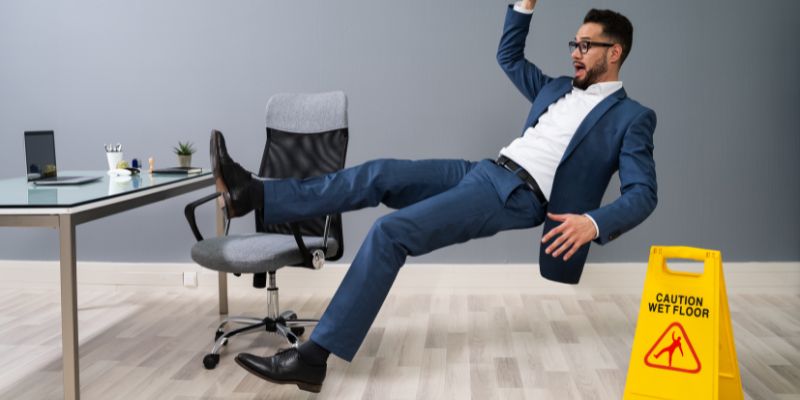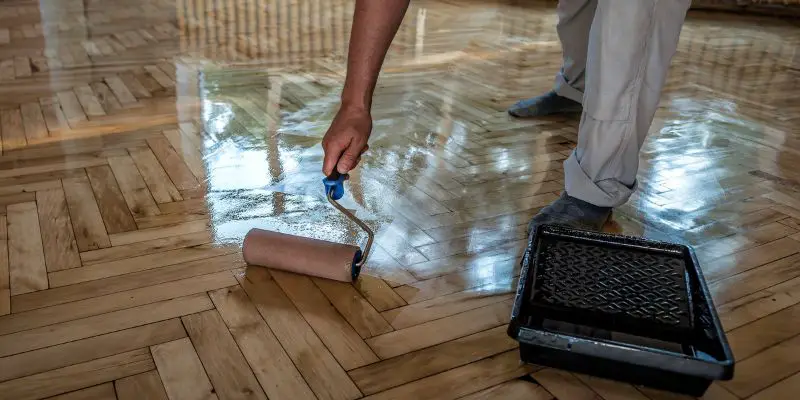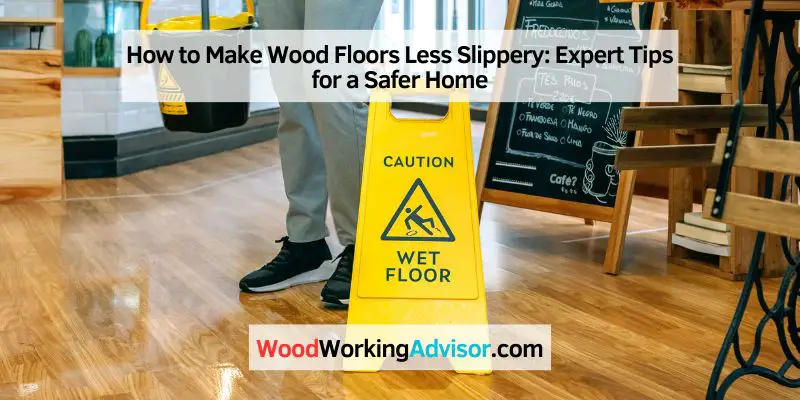To make wood floors less slippery, you can use anti-slip products or treatments.
Identifying The Issue
To prevent wood floors from being slippery, start by identifying the issue. Look for areas where the floor is especially slick, such as in high-traffic zones or near entryways. Consider factors such as the type of finish on the wood and the level of humidity in the room.
When it comes to wood floors, one common concern is slipperiness. Whether you have young children, or pets, or simply want to prevent accidents, it’s important to identify and address the issue of slippery wood floors. By understanding the risks associated with slippery floors and assessing their current condition, you can take the necessary steps to make your wood floors safer. Let’s dive into the details of how to go about it.
Understanding The Risks
Slippery wood floors pose a significant risk to the safety of those walking or running on them. One misstep could result in a fall, potentially leading to injuries such as sprains, fractures, or even concussions. Not only does this risk impact the well-being of your family and visitors, but it can also affect your own peace of mind. By understanding the potential hazards associated with slippery wood floors, you can proactively take measures to minimize the risk.
Assessing The Current Condition
The first step in addressing slippery wood floors is to assess their current condition. There are several factors that could contribute to the slipperiness of your floors, including the type of wood, the finish, and the presence of any contaminants. Take a close look at the surface of your wood floors and check for any signs of wear, such as scratches or dullness. Additionally, inspect the finish of the wood floors to determine if it has become worn or if it contains a high-gloss sheen, which can increase the slipperiness. By thoroughly examining the current condition of your wood floors, you can gain valuable insights into what needs to be addressed in order to make them less slippery.
In conclusion, identifying the issue of slippery wood floors is the first step toward creating a safer environment in your home. Understanding the risks associated with slippery floors and assessing the current condition of your wood floors are crucial in determining the appropriate actions to take. In the following sections, we will explore effective solutions to make wood floors less slippery, so you can enjoy the beauty of your wooden surfaces without worrying about accidents.

Choosing The Right Solution
When it comes to making wood floors less slippery, selecting the right solution is key. There are several options available to improve the traction of your wood floors and ensure safety for you and your loved ones. Two popular methods to consider are exploring non-slip coatings and considering area rugs or mats.
Exploring Non-slip Coatings
Non-slip coatings provide an effective and long-lasting solution to reduce the slipperiness of wood floors. These coatings are designed to create a textured surface that enhances traction and minimizes the risk of slipping. Applying a non-slip coating is a relatively simple process that can be done by DIY enthusiasts or professionals. In addition to increasing safety, these coatings also help protect your wood floors from wear and tear.
If you decide to explore non-slip coatings, it’s essential to select the right product for your specific wood floor. Consider coatings that offer good durability, water resistance, and compatibility with your wood floor finish. It’s wise to test the coating on a small, inconspicuous area of your floor before applying it to the entire surface to ensure compatibility and satisfy your expectations.
Once you have chosen the appropriate non-slip coating, follow the manufacturer’s instructions carefully for preparation and application. Properly cleaning and preparing the wood floor surface before coating ensures optimal adhesion and longevity. Remember to apply the coating evenly to achieve consistent traction throughout the floor.
Considering Area Rugs Or Mats
Another practical solution to reduce slipperiness on wood floors is to incorporate area rugs or mats. By strategically placing these accessories in high-traffic areas or areas prone to spills, you can create additional traction and increase safety without permanently altering the wood floor’s surface.
Consider these factors when choosing area rugs or mats:
| Material | Size | Cushioning | Grip |
| Opt for materials that offer good traction, such as rubber or non-slip fabrics. | Choose the right size to cover the desired area and fit well with the room’s layout. | Look for rugs or mats that provide cushioning for added comfort. | Ensure the rugs or mats have a non-slip backing or the ability to be secured to the floor. |
Remember to regularly clean and maintain the rugs or mats to prevent dirt and debris buildup that can decrease their effectiveness. Additionally, consider securing the edges of the rugs or mats to the floor using double-sided tape or rug pads to further minimize the risk of slips.
By exploring non-slip coatings and considering the use of area rugs or mats, you can effectively make your wood floors less slippery and create a safer environment for everyone in your home.
Implementing Preventive Measures
Cleaning And Maintaining Regularly
Regular cleaning and maintenance of wood floors can significantly reduce slipperiness. Sweep or vacuum the floor to remove dust, dirt, and debris. Use a damp mop with a mild cleaner to gently clean the surface. Avoid using excessive water, as it can create a slippery film. Buffing the floor can help restore traction and minimize slipperiness.
Using Traction Tape Or Strips
Applying traction tape or strips to wood floors is an effective way to enhance grip and minimize slipping hazards. These self-adhesive products can be strategically placed in high-traffic areas or places where slipping is more likely to occur, such as entryways or wet zones. Ensure the tape or strips are securely attached to the floor to provide maximum traction.
Optimizing Footwear For Safety
Selecting Anti-slip Soles
Choosing shoes with anti-slip soles is a key step in enhancing your safety on wood floors. These special soles are designed with materials that provide superior traction and grip, ensuring a stable footing even on slippery surfaces. When selecting anti-slip shoes, keep the following points in mind:
- Look for shoes with a rubber sole that offers excellent traction.
- Consider shoes with deep grooves or patterns on the sole, which further enhance their grip.
- Opt for shoes that have a wider toe box to allow better balance and stability.
In addition to providing better safety on wood floors, shoes with anti-slip soles can also be versatile and fashionable. They come in various styles and designs, allowing you to prioritize both safety and style.
Utilizing Slip-resistant Socks
Another way to enhance safety on wood floors is by utilizing slip-resistant socks. These socks are specially designed with added grip, preventing your feet from sliding on smooth surfaces. Here are some considerations to keep in mind when using slip-resistant socks:
- Choose socks with a rubberized or silicone grip on the sole, as they provide maximum traction.
- Ensure that the grip is evenly spread across the entire sole of the sock for consistent traction.
- Opt for socks that fit snugly to avoid any slippage or discomfort.
Slip-resistant socks are not only practical but also comfortable. Many brands offer a range of colors and designs, allowing you to prioritize safety without compromising on style.
Seeking Professional Assistance
Seeking professional assistance can be a wise decision when it comes to making your wood floors less slippery. By consulting with flooring specialists and hiring professional floor refinishers, you can ensure that your floors are properly treated and safe for everyone in your home. Let’s explore these options in more detail:
Consulting With Flooring Specialists
Consulting with flooring specialists is the first step towards making your wood floors less slippery. These experts have in-depth knowledge and experience in dealing with various flooring issues, including slipperiness. They can assess the condition of your floors and recommend the most suitable solutions to enhance their traction.
Here are a few ways in which flooring specialists can assist you:
- Conducting a thorough inspection of your wood floors to identify potential areas of concern.
- Suggest specific products or treatments that can be applied to increase the traction of your floors.
- Providing professional advice on maintenance practices to prevent slippery conditions in the future.
By consulting with these experts, you can gain valuable insights and guidance on addressing the slipperiness of your wood floors effectively.
Hiring Professional Floor Refinishers
Another option to consider when seeking professional assistance is hiring professional floor refinishers. These skilled professionals have the expertise and tools necessary to refinish your wood floors and improve their safety.
Here are some advantages of hiring professional floor refinishers:
- They have the knowledge to choose the most suitable non-slip finishes or coatings for your specific wood flooring type.
- They can eliminate any existing slippery surface coatings and replace them with safer alternatives.
- They possess the necessary equipment to ensure a precise and even application of the chosen finish, reducing the risk of uneven surfaces that might contribute to slipperiness.
When you hire professional floor refinishers, you can have peace of mind knowing that their expertise will result in safer, less slippery wood floors for you and your loved ones.

Frequently Asked Questions For How To Make Wood Floors Less Slippery
How Do I Stop My Wooden Floor From Being Slippery?
To prevent your wooden floor from being slippery:
1. Clean your floor regularly to remove dirt and dust.
2. Use a non-slip rug pad under area rugs to provide traction.
3. Apply an anti-slip treatment or coating to the floor surface.
4. Use non-slip floor mats in areas prone to water or spills.
5. Consider using non-slip socks or shoes to reduce the risk of slipping.
What Is The Solution For Slippery Floor?
To tackle a slippery floor, you can use various solutions like applying anti-slip coatings, using non-slip mats or tapes, ensuring proper floor cleaning techniques, wearing non-slip footwear, and maintaining adequate floor moisture levels.
How Do You Make A Wood Surface Not Slippery?
To make a wood surface less slippery, try applying an anti-slip coating or adding texture. Sanding the surface can also improve grip. Regular cleaning and maintenance will help maintain the anti-slip properties.
How Do I Make My Wood Floor Less Slippery For My Dog?
To make your wood floor less slippery for your dog, you can try these tips:
1. Use pet-friendly, non-slip rugs or mats in areas your dog frequents.
2. Apply an anti-slip solution specifically designed for wood floors.
3. Keep your dog’s nails trimmed to improve their grip.
4. Opt for dog-friendly paw wax to enhance traction.
5. Keep the floor clean and free of any slippery substances or spills.
Conclusion
Making wood floors less slippery is essential for safety and peace of mind. By following the tips and techniques mentioned, you can effectively reduce the potential for slips and falls on your wood floors. It’s important to prioritize safety and take proactive measures to create a secure and comfortable living environment.


